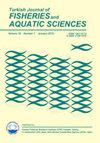黑海浮游鱼类的遗传鉴定及其丰度和群落组合
IF 1.7
4区 农林科学
Q3 FISHERIES
引用次数: 0
摘要
浮游阶段鱼类的准确识别对于检测鱼类的产卵、觅食和生长地点至关重要,为种群评估、环境影响评估和生态监测提供数据。在本研究中,调查了黑海东南部季节性鱼类浮游生物的丰度、群落组成以及影响其群落组成的主要可能环境驱动因素。从四个站点、两个沿海站点和两个近海站点季节性采集了一年的鱼类浮游动物样本。应用DNA条形码方法对浮游鱼类标本进行鉴定。在使用DNA条形码鉴定的33个鱼类浮游生物分类群中,由于公共数据库中没有来自黑海的参考序列,31个分类群在物种水平上鉴定,2个分类群是在属水平上鉴定。Engraulis encrasicolus、Sprattus Sprattus、Mullus barbatus和Trachurus mediteraneus被确定为最丰富的物种。仅昂氏虫就占总捕获量的近91.5%。季节性对鱼类浮游生物组合有很大影响。浮游生物丰度最高的是夏季,其次是冬季、秋季和春季。夏季鉴定出30个鱼类类群,春季鉴定出10个,秋冬各鉴定出3个。鱼类浮游动物群落在夏季主要为E.encrasicolus、M.barbatus和T.mediteraneus标本,在冬季主要为S.sprattus和M.merlangus标本,在秋季主要为S.sprattus和G.mediteranius标本,在春季主要为Alosa immaculata和Merlangius merlangus。各季节沿海站点的浮游鱼类丰度和丰富度普遍较高。Engraulis encrasicolus、S.sprattus、M.merlangus和P.incognitus是唯一在4次以上的运输中检测到的物种。另一方面,M.batrachocephalus、P.flescus、S.abester、T.draco、U.cirrosa和C.lucerna仅在一次运输中被检测到。总体而言,影响浮游鱼类丰度的主要环境变量是温度。基于nMDS分析的群落组成与环境变量之间的关系表明,浮游植物群落结构也受到盐度、溶解氧、叶绿素a、NO2和NO3的影响。本文章由计算机程序翻译,如有差异,请以英文原文为准。
Genetic Identification of Ichthyoplankton in the Black Sea and Their Abundance and Community Assemblages
Accurate identification of fish species during the planktonic stages is vital for detecting spawning, foraging, and growth sites of fish species to provide data for stock assessment, environmental impact assessment, and ecological monitoring. In this study, seasonal ichthyoplankton abundance, community composition, and main possible environmental drivers that influence their community composition were investigated in the Southeastern Black Sea. Ichthyoplankton samples were seasonally collected for a year from four stations, two coastal and two offshore sites. DNA barcoding method was applied to identify ichthyoplankton specimens. Of 33 ichthyoplankton taxa identified using DNA barcoding, 31 taxa were identified at species level and 2 taxa were identified at genus level due to unavailability of reference sequences from the Black Sea in public databases. Engraulis encrasicolus, Sprattus sprattus, Mullus barbatus, and Trachurus mediterraneus were identified as the most abundant species. Engraulis encrasicolus alone accounted for nearly 91.5% of the total catch. Seasonality had a strong influence on the ichthyoplankton assemblages. The highest ichthyoplankton abundance was found in summer, followed by winter, autumn, and spring. While 30 fish taxa were identified in summer, 10 taxa were identified in spring, 3 taxa were identified in both autumn and winter. Ichthyoplankton communities were dominated by E. encrasicolus, M. barbatus, and T. mediterraneus specimens in summer, S. sprattus, and M. merlangus specimens in winter, S. sprattus and G. mediterraneus specimens in autumn, Alosa immaculata and Merlangius merlangus in spring. The ichthyoplankton abundance and richness was generally higher in coastal stations in each season. Engraulis encrasicolus, S. sprattus, M. merlangus, P. incognitus were the only species that detected in more than 4 hauls. On the other hand, M. batrachocephalus, P. flesus, S. abester, T. draco, U. cirrosa, and C. lucerna were only detected in a single haul. Overall, the dominant environmental variable affecting abundance of ichthyoplankton was temperature. The relationship between community composition and environmental variable based on nMDS analysis indicated that ichthyoplankton assemblage structure is also influenced by salinity, dissolved oxygen, chlorophyll-a, NO2, and NO3.
求助全文
通过发布文献求助,成功后即可免费获取论文全文。
去求助
来源期刊

Turkish Journal of Fisheries and Aquatic Sciences
FISHERIES-MARINE & FRESHWATER BIOLOGY
CiteScore
3.10
自引率
0.00%
发文量
43
审稿时长
3 months
期刊介绍:
Turkish Journal of Fisheries and Aquatic Sciences" (TrJFAS) is a refereed academic journal has been published by Central Fisheries Research Institute of Turkey and Japan International Cooperation Agency (JICA), and published in English.
It aims to address research and needs of all working and studying within the many varied areas of fisheries and aquatic sciences.
The Journal publishes English language original research papers, critical review articles, short communications and technical notes on applied or scientific research relevant to freshwater, brackish and marine environments.
TrJFAS was published biannually (April & November) between 2001 and 2009. A great number of manuscripts have been submitted to the journal for review from acceptance of the SCI index. Thereby, the journal has been published quarterly (March, June, September and December) from 2010 to 2017. The journal will be published monthly in 2018.
 求助内容:
求助内容: 应助结果提醒方式:
应助结果提醒方式:


